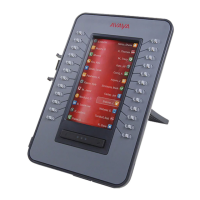• improves security
• improves network management
The networking standard that describes VLANs is IEEE 802.1Q. This standard describes in detail
the 802.1Q protocol and how Ethernet frames get an additional four-byte tag inserted at the
beginning of the frame. This additional VLAN tag describes the VLAN ID that a particular device
belongs to and the priority of the VLAN tagged frame. Voice and video traffic typically get a higher
priority in the network as they are subject to degradation caused by network jitter and delay.
Related links
VLAN separation on page 115
External switch configuration on page 117
Exceptions to the VLAN forwarding rules on page 118
Special considerations on page 118
VLAN parameters on page 119
VLAN separation
The Avaya J100 Series IP Phones has an internal network switch that is capable of using VLANs
to segregate traffic between the LAN port, the PC port and the internal port that goes to the CPU
of the phone. You can have VLAN functionality on this switch and configure the switch to isolate
the traffic destined for the CPU of the phone from the data destined to the PC port.
The configuration of the internal switch of the phone can be done through the
46xxsettings.txt file, LLDP or DHCP. It is preferable to configure the VLAN settings on the
internal switch of the phone through DHCP or LLDP as these protocols are run prior to and during
network initialization. If that is not possible then the 46xxsettings.txt file configuration
parameters can be used and the VLAN can be started in automatic mode which is the default
mode.
Virtual LAN (VLAN) overview
December 2018 Installing and Administering Avaya J100 Series IP Phones 115
Comments on this document? infodev@avaya.com

